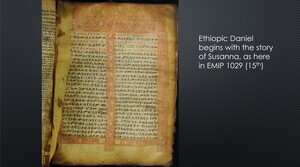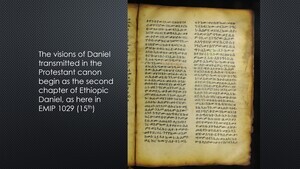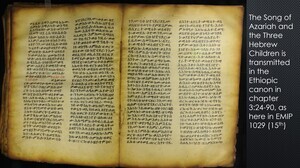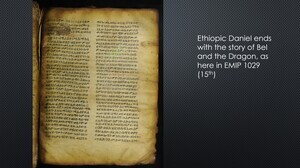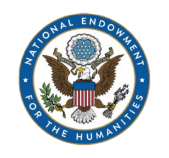About US
History of the THEOT Project
Around 2003 Delamarter was invited by Emanuel Tov and Armin Lange to serve as area editor for Ethiopic translations in Brill’s upcoming project on the Textual History of the Bible. Since this request came while the project was still in its planning stages, Delamarter had several years to begin the process of locating manuscripts. Delamarter was trained in biblical studies at Western Evangelical Seminary (MATS and MDiv, 1979). He did a Masters and then completed a doctoral degree (1990) at Claremont Graduate School with James A. Sanders in Old Testament and Early Judaism. For two years, he served as Director of the Ancient Biblical Manuscript Center at the School of Theology at Claremont, where Sanders was President. In the following two decades he taught courses at the School of Theology’s summer school for the United Methodist Church, at Azusa Pacific University and Seattle Pacific University’s biblical studies departments, and then as Professor of Biblical Studies at George Fox University. Delamarter corresponded with Tov on his work about Scribal Practices in Evidence in the Dead Sea Scrolls and formulated a plan to go to Israel and Ethiopia to learn more about scribes and their work in the religious communities they served.
Carousel 1
In 2005, Delamarter spent part of a sabbatical year in Jerusalem where Kristen Stoffregen Pedersen (a Bridgettine Sister from the monastery there in Jerusalem) introduced him to members of the Jerusalem Ethiopian community. Among them was Daniel Alemu, whose father was a deacon in the church and whose mother was a member of the Christian Arabic community in the Old City. In April and May, Delamarter and Daniel went to Ethiopia where Delamarter secured an affiliation with the Institute of Ethiopian Studies. Elsabet Giyorgis was director of the Institute of Ethiopian Studies (IES) at the time, and Ato Demeke Berhane was the director of the Manuscripts and Archives Department. After a week of initial manuscript studies in Demeke’s department, Delamarter and Daniel, traveled around the country (including Addis Ababa, Bahir Dar, Iste, Gelawdawos, Axum, Dabra Damo, and Dabra Libanos) and located and interviewed 22 scribes, using a series of questions that Delamarter had developed with a cultural anthropologist at Portland State University. The questions were aimed at refining an understanding of the social location of scribes in relation to the communities they served, their educational processes, and the economic engines for their livelihoods.
Shortly after his return from Ethiopia, Delamarter started a project to locate and digitize Ethiopian manuscripts in North America, the Ethiopic Manuscript Imaging Project (EMIP). Roger Rundell, and then Jeremy Brown were assistants in the EMIP project doing early work in manuscript digitization and metadata collection. As more and more manuscripts were discovered and digitized, Delamarter developed an ongoing relationship with Professor Getatchew Haile, curator of Ethiopic Manuscripts in the Hill Museum and Manuscripts Library (HMML) in Collegeville, Minnesota. Once or twice a year for the next decade he traveled to Collegeville where Getatchew mentored him and others (including Jeremy Brown, Roger Rundell, Demeke Berhane, Daniel Alemu, and Kesis Melaku Terefe) in various skills related to manuscript studies, Ethiopic paleography, and the intricacies of creating metadata for Ge’ez manuscripts.
Carousel 2
In 2008, as chair of the Society of Biblical Literature (SBL) section on the Textual Criticism of the Hebrew Bible, Delamarter organized an exploratory session in which a panel of eight presenters was lined up to research and describe the contents of the ten largest collections of Ethiopian manuscripts in North America. This event brought together people interested in Ethiopian manuscript studies and gave attention to fundamental questions for the field: Where are Ethiopian manuscripts in North America, how many are there, and what are their contents? In that one session, the panel revised the estimate of “nearly 400” made by Richard Pankhurst1, to nearly 2,200 known to us. Even more important, though, was the interest shown in the topic. Delamarter and others formulated a proposal to the SBL to form a Consultation on Ethiopian Bible and Literature in 2009. This ran for three years and then was promoted to status as a full Program Unit in 2012 and remains so to this day.
In 2009, Ato Demeke asked Delamarter to collaborate with him on a proposal to the British Library’s Endangered Archives Programme (EAP) for a digitization and preservation project with the manuscripts of the IES collection. The grant was secured and Delamarter and Jeremy Brown lived and worked in Addis Ababa for six months at the beginning of 2010. A team of three additional digitizers, Hailemariam Aleyu, Sileshi Kebede, and Makonnen Desta–all deacons in the Ethiopian Orthodox Tewahedo Church and philology students at Addis Ababa University–was hired and trained. The team was able to digitize 5,749 items and place the most fragile of them into conservation boxes. In the course of that work, Delamarter and Brown led a half dozen digitization workshops. The first of these was in partnership with Wayne Torborg, director of digital collections at HMML.
During the six months of the EAP project at the IES, the leaders there asked us to digitize several collections of microfilms. This was work done outside of the support of the EAP program and was funded by EMIP. The authorities at the IES were keen to have this done since they had almost no working microfilm readers and the ones they did have were doing damage to the microfilms. Even worse, many of these microfilms had no circulation copies. Among the collections of microfilms we digitized was the very important collection of about 360 manuscripts microfilmed in 1960 and 1970 by the UNESCO mobile microfilm unit. Several of the manuscripts in this collection were important manuscripts of the Ethiopic Old Testament.
Also during this time, Delamarter made contact with Daniel Assefa who, until around 2020, lived and worked at a Capuchin-Franciscan monastery in Asko, on the northwest edge of greater Addis Ababa. The two had met at the 2009 International Conference of Ethiopian Studies held outside of Addis Ababa at the Akaki Campus of the University. They had been scheduled alongside one another in a session and struck up a conversation and made notes to maintain contact. Delamarter subsequently learned from Daniel that his community had a collection of more than two hundred manuscripts, including a subset of very fine manuscripts which had formerly belonged to Nabura ‘Ed Dametros. So, while living and working there in Addis, Delamarter traveled to the monastery with Ato Kaleab Demeke, son of Demeke Berhane, to view the collection. Delamarter had trained Kaleab in manuscript digitization and used him in a first digitization feasibility study at the IES. Daniel was very open about the need to digitize the collection and he and Delamarter made arrangements for Kaleab to do the job. Among these are several fine manuscripts containing Old Testament books.
Also during this time, Delamarter made contact with Mehret-Ab Bereke, librarian at the Mekane Yesus Seminary (MYS) in the Mekanisa section of Addis Ababa. The Seminary owns a collection of 54 manuscripts most of which had been gathered some decades previously by Ethiopian scholar, Meseret Sebhat-leAb. Dr. Loren Bliese had made introductions for Delamarter into the seminary community and they graciously opened their doors for Delamarter and Kaleab to come and digitize everything there. Among these were a few volumes of the Photolithographic edition of the Haile Selassie Bible, several Psalters, and many non-biblical works. With the help of Ato Demeke, Delamarter located and purchased a substantial fragment of a late 15th century manuscript of the book of Jubilees and the Minor Prophets. He donated the manuscript to MYS and digitized it along with the others.
Throughout 2010 and a few years afterwards, Kaleab and Delamarter ran a “catch and release” program with various dealers in Addis Ababa, renting manuscripts for a day or two, just long enough to digitize them and return them to the owners. Over the course of several years this program has digitized several hundred manuscripts, though only a few of them contained books of the Ethiopic Old Testament besides the Psalter.
After the work at the IES was completed, Hailemariam and Delamarter developed relationships with several churches in various places in the country which allowed Ato Hailemariam to digitize their collections. Over the next two years, Hailemariam traveled to these places and digitized several hundred manuscripts. Among these were many more valuable manuscripts of the Ethiopic Old Testament.
In late 2010 Curt Niccum and Delamarter began working together to organize a team approach to work on the textual history of the Ethiopic Old Testament. Niccum had studied New Testament textual criticism with Carroll Osburn at Abilene Christian University as part of an MDiv Degree (1993), and wrote his dissertation on the Ethiopic Book of Acts under Greg Sterling at University of Notre Dame (2000). From 1995-2003, he worked on the Dead Sea Scrolls project with Eugene Ulrich, co-editing 4QDand, among other things. Eventually he joined the teaching faculty at Abilene Christian University. For several years he has served as Editor of the Ethiopic Evidence for the Novum Testamentum Editio Critica Maior. Currently he also serves as the Assistant Director of the Center for the Study of Ancient Religious Texts (CSART). Niccum and Delamarter made plans to work together at HMML the following summer (2011), starting the work of manuscript transcription that would be such a fundamental part of the emerging work of the Textual History of the Ethiopic Old Testament Project (THEOT).
By 2011, Delamarter had begun offering workshops and courses in Ethiopian manuscript studies to his students. In addition to these, he offered summer workshops in which they worked out the double-blind process of manuscript transcription. In the course of this work, they created electronic base texts for several books of the Ethiopic Old Testament, including for the entire book of Jeremiah for use by Martin Heide in his upcoming project to create a critical edition of the Ethiopic Jeremiah cycle. After 2011, these workshops in Ethiopic manuscript studies began to experiment with creating transcriptions of 30 manuscripts of the book of Obadiah and a few other Old Testament books.
In 2012, Ralph Lee attended the SBL Annual Meeting in Chicago, Illinois. He and Delamarter had met in Addis Ababa in 2009. Lee had first come to Ethiopia in 1990 and then lived there from 1997 to 2005. He came with a background in Engineering and helped to establish a department of chemical engineering at Bahir Dar University. While there, he took up the study of Amharic and later Ge’ez. He took a masters in African and Asian Christianity at the School of Oriental and African Studies, University of London (SOAS), completed in 2007, with modules focused on Eastern Christianity. From that coursework, Lee went on to take a PhD at SOAS in the department of the Study of Religions, on the subject of Symbolic Interpretations in Ethiopic and Ephremic Literature (completed 2011). Delamarter and Lee had been exploring a topic for an SBL Annual Meeting presentation from Lee. He expressed interest in text variants in the Ethiopic biblical tradition as recorded in the traditional commentaries known as Andemta. Lee had recently become Assistant Professor of Eastern Patristics at Holy Trinity Theological College in Addis Ababa, and Head of Research. At that meeting in Chicago, Lee expressed interest in being the principal investigator for THEOT’s work on Ethiopic Deuteronomy. In subsequent years, he has presented various papers at SBL Annual Meetings and joined the leadership team of THEOT. In 2014, he and his family returned from Ethiopia to their home in Cambridge, England, where he and Delamarter settled into work on Ethiopic Deuteronomy.
In 2013, Garry Jost, a computer programmer living near Portland, Oregon, and adjunct professor of biblical studies at Marylhurst University, joined Delamarter’s workshops. Jost’s first bachelor degree (1980) was in German and Spanish, which he taught for two years in a high school in Kansas. This provides a window into his lifelong interest in and aptitude for languages. A second bachelor degree (1983) was in computer science at Wichita State University. This led to a Master’s degree in computer sciences at University of Wisconsin - Madison (1990) with a specialization in computer databases and artificial intelligence. He moved into a career of computer programming for industry, where he has worked for more than 25 years. Jost also pursued training in theological studies with an MDiv (Associated Mennonite Biblical Seminary), and a DMin (Drew University), with a concentration in biblical languages.
Jost began giving leadership to the THEOT work on Ethiopic Obadiah. It occurred to him that several of the processes we were doing to align and compare the texts of the manuscripts, could be automated with computer scripts, written and executed in the Google Scripts App environment. Once one step had been automated, it inevitably opened the door for a next manual operation that, in turn, could be automated. Thus ensued an ongoing process in which Delamarter, Jost, and Brown (with increasing input from Niccum, Lee, and Assefa as they joined the project) worked out the steps of a distinctively text historical methodology and the means by which it could be supported by technological tools and processes. That process has continued into the present.
Around 2012/2013, Delamarter and Niccum formalized their co-directorship of the THEOT project and began guiding workers in the first steps of transcriptions and data processing related to the textual history of the first books that we would study in depth: Obadiah, Deuteronomy, Amos, and a few others. In July 2013, several members of the team attended the EMML at 40 Conference at the Hill Museum and Manuscripts Library. Niccum, Brown, Jost, and Delamarter used the occasion to transcribe a number of manuscripts that had been inaccessible to this point. For the next several years, the team settled into the work of generating transcriptions of manuscripts of several more Old Testament books, and continued to refine the workflow and the computer scripts to support it.
In 2014, we received word that the Textual History of the Bible project was ready to begin receiving articles. Delamarter and Niccum brought together a team of contributors and produced twenty-one articles for the first volume. Most of these articles were exercises in secondary literature supplemented with a few findings we had made in our own work in textual history.
In this timeframe, Delamarter had been working with Alessandro Bausi, director of the Hiob Ludolf Centre for Ethiopian Studies, to arrange a presentation by Bausi at the SBL Annual Meeting. Bausi was able to do so in 2015, at the November meeting in Atlanta, Georgia. His presentation was coordinated with the completion of the monumental Encyclopedia Aethiopica project. The meeting in Atlanta gave occasion for more fruitful conversations about our plans for the study of textual history. In June 2015, Delamarter and Jost, and one of Delamarter’s students, Samuel Aldridge, went to Hamburg to consult with Professor Bausi and the team there about our approach to the work on textual history. Ralph Lee came from Cambridge as did Albert ten Kate (THEOT investigator on the Psalms) from the Netherlands, Martin Heide from Germany (working on a critical edition of Ethiopic Jeremiah), and Ulrich Schmid (a collaborator for the New Testament Virtual Manuscript Room operated by the Institut für neutestamentliche Textforschung) from elsewhere in Germany. Curt Niccum joined the meetings via zoom. For two generous days, Bausi and his team listened to our thinking and gave very helpful input both with regard to our desired outcomes and also for the workflow issues necessary to get there.
In 2019, Tov invited a contribution from our team for the journal Textus on the progress of THEOT. We published “The Textual History of the Ethiopic Old Testament Project (THEOT): Goals and Initial Findings” in 2020.
Likewise in 2019, the team crafted a proposal to the National Endowment for the Humanities (NEH) for support that would allow us to give fuller energies to the work of THEOT. The grant would buy out additional time for Curt Niccum, pay Garry Jost for three hours a week of programming, acquire a few hours a week of the time of two data scientists to work on the issues of digital supports for the products produced by the project, and employ Daniel Assefa and a team of manuscript transcribers from Addis Ababa to prepare transcriptions. Delamarter and Lee volunteer their time for the project. In that proposal we committed to publish reports on several books of the Ethiopic Old Testament as well as online resources for research on the subject of the textual history of the Ethiopic Old Testament. The grant was funded and the team set into its work with new vigor.
ENDNOTES
1 “A Serious Question of Ethiopian Studies: Five Thousand
Ethiopian Manuscripts Abroad, and the International Community,”
originally published in the Addis Tribune, but now available only
here.
